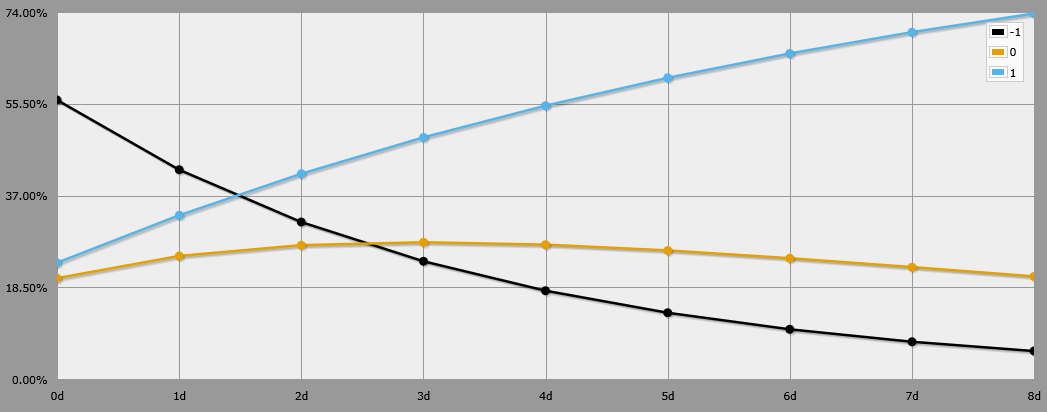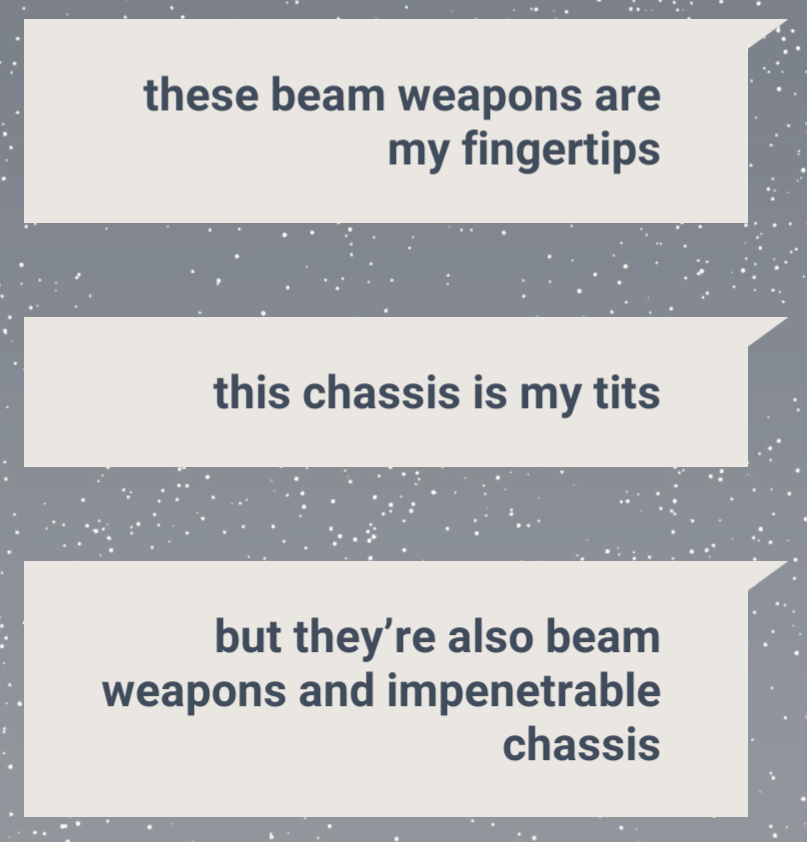I definitely thought I’d be following up my last post to talk more about The Serket Hack, but the mecha thoughts have been hounding me this week. In particular, the thriving mechsploitation community over on bluesky lives rent free in my head. Let’s talk about Full Metal Bones.
The core of FMB is purely a desire to write my own mecha game and put that into the world. Unlike The Serket Hack, I didn’t have a strong vision for the specific fantasy I wanted to replicate, because I enjoy a broad variety of mecha fiction. Mecha run the gamut from magical super robots to slightly more realistic mobile suits to almost near-future tachikoma. I had vague ideas of what I wanted to involve, but almost immediately I got lost in the numbers.
Math Shenanigans

Born out of disgust for the popular Powered By The Apocalypse 2d6 dice resolution, I started experimenting with probability. (One day I’ll elaborate on my beef with PBTA but we have too much ground to cover in this post.) My initial goal was to create a conflict resolution method which rewarded and reinforced characters who were good at specific things. In many situations with PBTA 2d6, it was often better to find a way to not roll the dice, because the complications of a partial success would make the situation worse than doing nothing at all. Despite the aversion for partial success, I was loosely recreating Forged In The Dark Xd6 dice resolution without realizing it.

The second resolution method was purely based around my love of d8’s. A player would roll 2 or more d8:
- If any dice came up “8”, that was a full success
- If the player could add two dice to equal 8, that was a partial success
- Otherwise, the roll was a failure
The above graph shows the odds of failure (black), partial (orange), and success (blue).
SIN Engines
Much of the early ideation for FMB was done as part of a game jam on the now-defunct Papercult forums. Papercult was briefly a set of PHPBB forums for tabletop RPG designers in ~2023 before it became a short-lived newsletter. The proprietor, Charlotte Lakowski, has since pivoted to a new blog and my earliest pitch for Full Metal Bones is no longer accessible. I have a couple of documents full of notes about the game, but not what the SIN Engine was originally pitched as.
Conceptually, I wanted to evoke the concept of a reactor that became more efficient and more dangerous the hotter you ran it. The other half of the mechanic is the idea of limited fuel: the more you burn on a current fight means less fuel in later encounters. Still: some fuel must be burned for your machine to move at all. The trick is figuring out a happy middle-ground and keeping your mech running in the sweet spot.
Mech Types
The existence of SIN Engines split mechs into two categories: mass production units and custom SIN rigs called daemons. Inspired by countless mech media featuring prototype suits fighting grunt machines, I wanted to place the choice in the hands of the player. A mass production mech is going to be easier to acquire, easier to maintain, and generally more reliable in combat. A daemon has the potential to be many times stronger, but on average more unreliable and “swingy”. Of course, both have the capability to be modified to compensate for their weaknesses through upgrades.
In the initial vision for the game, the different mech types would use the two different forms of dice resolution listed above. Mass production units would roll Xd6 in combat and take the two highest to try and roll an 8+ for a success. Daemons would burn SIN, which would determine how many d8 they would roll to try and get/assemble an 8. The total amount of SIN they could carry would be limited, and if they ran out, their reactor would shut down.
Resource Management
Ultimately however, I still don’t really like the structure of the conflict resolution, and I could tell it at the time. Shortly before I stopped design work on FMB, I had been adding a third system to conflict resolution, inspired by the diceless subsystems in NOVA. Instead of having the dice determine success or failure directly, I reworked them to generate a meta currency called “tension”.
Each player started with 3 tension at the beginning of combat. On their turn, they roll to see the tides of battle. On a success, they gain 3 tension. On a failure, they gain 1 tension and a complication. Tension could be spent to activate abilities and attack or stored in reserve up to a certain limit. This allows players to charge up bigger moves and go all out.
Presently, I really like the tension system as a framework for mech battles, but I would probably rework the mechanics to ensure that the pacing feels correct and the resource economy works out.
Support Crew
Rather than having conventional gear, I wanted to represent the connection between pilots and their support staff. “Gear” would take the form of supporting crew. The mechanic who installs your new arm cannon gives you a new weapon and you write their name down on your character sheet. In the earliest brainstorms for Full Metal Bones, you could sacrifice members of your crew to succeed on an action. While I no longer think that crew sacrifice is a mechanic I want, I do like the idea of crew-as-gear, and I’ve had more time to think about aspects of mech support crews lately.
Weapon Type Advantage
At some point during the design process, I drafted a complicated combat system to represent the granular advantages of various weapon types. Each attack had range, penetration, and effectiveness against various types of enemy defense, and the defender could respond to certain things (i.e. shooting down missiles). Individual ammo was a large consideration. I still like the broad strokes of this desire: artillery mechs should feel like artillery mechs. A missile swarm should work differently than a melee brawler. I dislike a lot of mecha ttrpgs that reduce “attack” down to one or two stats and un-typed “damage”, because it makes the mech customization less important. However, I also think having a very crunchy combat calculation on top of the already complicated tension generation is bad.
I think I can refine my thoughts on weapon types to a viable system. The trick is relying on the tension system to handle whether a player can make an attack, and then a circle of type comparison to see whether an attack does normal/reduced/extra damage.
Setting Thoughts
The main thought that I had when designing Full Metal Bones involved the exploration of a relationship between pilot and mech: physically, romantically, sexually, existentially. Each time a pilot would otherwise die in FMB, the machine instead takes a limb, replacing it with a cybernetic interface. If the player rejects this, choosing to get a new body sculpt prosthetic, the machine views this as a rejection and the relationship suffers. On the fifth time a pilot would die, they must choose whether to give their heart to the machine. If they do, they become one with the mech and lose control of their body. The machine intelligence assumes control of their former body (and may or may not pilot you). If you choose to keep your heart, you no longer have the ability to pilot.
Body horror and involuntary body modification are themes I’m deeply interested in exploring with the game. Years later from my initial drafts, I’m also deeply interested in the broader themes of mechsploitation as a genre, and I consider my original ideas a part of it. Reading and absorbing ideas from other mechsploitation fiction will continue to inspire my setting design for Full Metal Bones. What happens when you turn a person into a weapon? What happens when a weapon becomes a person?

–Saturn from Heaven Will Be Mine
